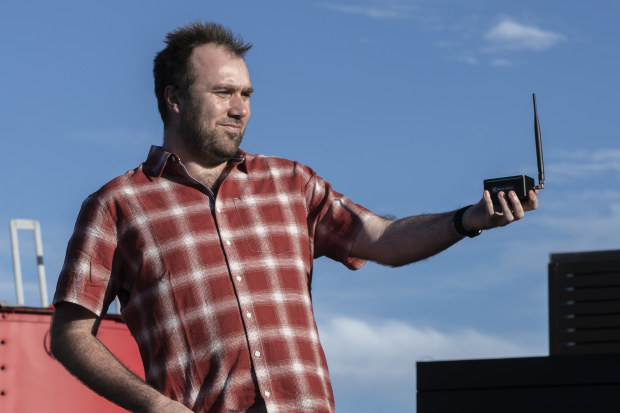Morse Micro dodges semiconductor crisis thanks to strong links to Asia

Australia’s largest semiconductor company, Morse Micro, has shaken off the global semiconductor shortage to ramp up the production of its tiny Wi-Fi HaLow chips.
While Apple and Samsung scramble to get their hands on super fast chips amid a worldwide shortage, the Sydney-based start-up has leveraged strong relationships with Taiwanese manufacturers to bring its low-power, long-range Wi-Fi chip to market.

Michael De Nil is the founder of Morse Micro, which has rolled out its Wi-Fi HaLow chips to customers. Louie Douvis
“Firstly, we are lucky because our chips are really tiny, so we can fit thousands of them on a single silicon wafer,” Michael De Nil, the founder and chief executive of Morse Micro, said.
“And secondly, we’ve got excellent relationships with the manufacturers in Asia, so we don’t have an issue getting our supply.”
Mr De Nil credits those relationships to his previous employer, US-based semiconductor giant Broadcom, where he and Morse Micro co-founder Andrew Terry cut their engineering teeth.
Since the pair left Broadcom to establish their own semiconductor business in 2016, they have focused on developing chips that can reach 10 times the range of conventional Wi-Fi technology and last many years on a single battery.
“Rather than join the race to develop the next generation of faster and faster chips, we took a step back and looked at a much narrower bandwidth that can go much further than normal,” Mr De Nil said.
With its high frequency and wider channels, traditional Wi-Fi is failing to meet the unique requirements of an internet-of-things environment, which includes things such as automatic lights, doorbells, security systems or any connected device not operated by humans, he said.
“This ultimately means shorter reach, limited penetration through obstacles and higher power consumption,” he said.
Morse Micro is selling its Wi-Fi HaLow chips to original equipment manufacturers. The global semiconductor shortage has dominated headlines since the COVID-19 pandemic prompted a rapid digitisation of industries and sent OEMs into a panic.
Semiconductors are essential to the production of integrated circuits or chips, with a single chip sometimes including thousands or even millions of semiconductors.
Taiwan accounts for 73 per cent of global semiconductor revenue, and it is struggling to keep up with demand.
As for developing new semiconductor facilities, the Semiconductor Industry Association estimates that a new foundry costs from $US10 billion ($13.6 billion) to $US20 billion, depending on the type of chip to be produced. Over a decade, including initial costs and retooling, such a facility could cost up to $US40 billion
Fortunately for Morse Micro, the size of its chips mean they can get more from less.
“It’s really an issue when you can only fit a few chips on a single wafer, and at the moment there are serious issues with getting enough wafers,” Mr De Nil said of the semiconductor manufacturing process.
“Our chips are really tiny, so we can fit thousands of them on a single silicon wafer,”
Morse Micro, which has raised $42 million to date from investors including Blackbird Ventures and Main Sequence Ventures, has a team of more than 100 people across Australia, the United States, China and India.
The company is the largest semiconductor employer in Australia, but is finding sourcing talent more difficult as the borders remain closed.
“At first it was easy – we would just hire from other companies – but we’ve kind of tapped that out now,” Mr De Nil said.
“But now we’re trying to get flights for entire families to relocate where our officers are, and it’s taking them two months to get a flight and the only way to guarantee them a seat is via expensive business class tickets.”
Subscribe to gift this article
Gift 5 articles to anyone you choose each month when you subscribe.
Subscribe nowAlready a subscriber?
Introducing your Newsfeed
Follow the topics, people and companies that matter to you.
Find out moreRead More
Latest In Technology
Fetching latest articles